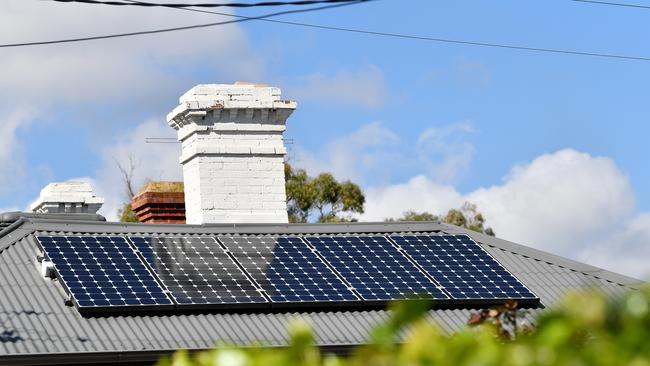Demand for solar batteries expected to rise as feed in tariffs rise in some states
Spiralling electricity prices and the falling cost of storage technology are expected to drive up demand for home batteries in the coming years.

Business
Don't miss out on the headlines from Business. Followed categories will be added to My News.
Spiralling electricity prices, state-by-state tariffs and ever-changing incentive schemes offered by state governments complicate the economics behind home batteries – but customer demand is expected to surge towards the end of the decade as the cost of storage technology declines.
According to the Australian Energy Market Operator, about 30 per cent of homes have solar panels. Just 5 per cent of those are supported by a battery system.
The high-up front cost – about $10,000 for a typical residential unit – and relatively long payback periods remain barriers to a higher take-up.
However Warwick Johnston, the founder of solar energy consulting firm SunWiz, said surging electricity prices were making home batteries more appealing.
“It’s certainly becoming more feasible – and if a state subsidy exists then it certainly makes it more feasible,” he said.
“The other thing which can make it feasible is a high difference between the cost of power at night time versus during the day.

“And particularly, what’s being offered as a feed-in tariff for any solar energy, and what they’re charging you to sell your electricity back in the evening. It’s a state-by-state variance – it’s based upon electricity prices that aren’t so strongly driven by wholesale electricity prices.”
Home batteries store solar power generated during the day, allowing a homeowner to use that supply at night or at other times of low solar power generation.
The larger the difference between electricity prices and feed-in tariffs – the rates paid to households for excess solar power fed back into the grid – the greater the savings can be.
Jenny Paradiso, who runs solar company Suntrix, said that while feed-in tariffs were falling in Victoria and South Australia, they were increasing in states such as Queensland and NSW due to the ongoing threat of energy shortages on the east coast.
“For the first time in ages we’re actually seeing some states looking at increasing the feed-in tariff,” she said. “I’m not saying that batteries aren’t worthwhile if that’s the case, but it’s always really important to have a look at the numbers. and the numbers that are the decision makers is how much you’re paying for electricity and how much they’re paying you to feed it back in.
“Five years ago I was telling more people not to buy batteries than encouraging them to buy them. Nowadays I’d say for 80 to 90 per cent it’s worthwhile.
“The price of batteries has gone down, the technology has definitely evolved and developed, and there’s a lot more selection out there, a lot more offerings in the market which always helps.”
Victoria, the ACT and South Australia all have solar rebates for batteries, while in NSW residents can access an interest fee loans for battery purchases.
However, South Australia recently scrapped its $2000 subsidy and in Victoria the rebate was cut from $3500 to $2950.
AEMO’s Integrated System Plan, which lays out a 30-year road map for the electricity market, suggests household battery take-up will “grow strongly in the late 2020s and early 2030s as costs decline, with most domestic systems complemented by battery energy storage by 2050”.
Clean Energy Council chief executive Kane Thornton said take-up was already increasing in light of the energy crisis which has seen prices spike and supply issues plague much of the east coast.
“We have seen a doubling of the volume of inquiries about household batteries as Australians respond to the recent energy crisis and look for ways to manage their own energy costs and supply,” he said.
“With over 3 million homes already with solar, we expect the demand for household batteries will grow quickly, particularly with inevitable increase in retail electricity prices on the way.
“The new federal government also made strong commitments to community-scale batteries to allow communities to play a role and deliver more local solutions.”
Anthony Albanese committed to installing 400 “community batteries” during the election campaign, with the first of these launched by The Yarra Energy Foundation in Melbourne.
Community batteries enable a group of households to feed into and draw electricity from a centralised battery – typically the size of a 4WD and providing up to about 500kWH of storage – located in their neighbourhood. Virtual power plants – where networks of connected solar panels and batteries are controlled by a central operator – are also emerging.
Mr Johnston said a mix of technologies was likely to evolve in Australia over the coming years.
“Another way people are actually going is to upsize their solar panel systems in anticipation that in the next couple of years they might buy an electric vehicle, which in some senses is like a mobile battery on wheels,” he said.
Angela Binns had a battery installed at her home on South Australia’s Fleurieu Peninsula in April, taking advantage of the state’s rebate scheme before it closes in September.
“We knew that it was going to be phased out so definitely that was a contributing factor,” she said. “It was that progression I think to go from panels to batteries, especially with all of the pricing and uncertainty around electricity, and also the whole greenhouse effect of doing our little bit to capture from the sun.”
Originally published as Demand for solar batteries expected to rise as feed in tariffs rise in some states




